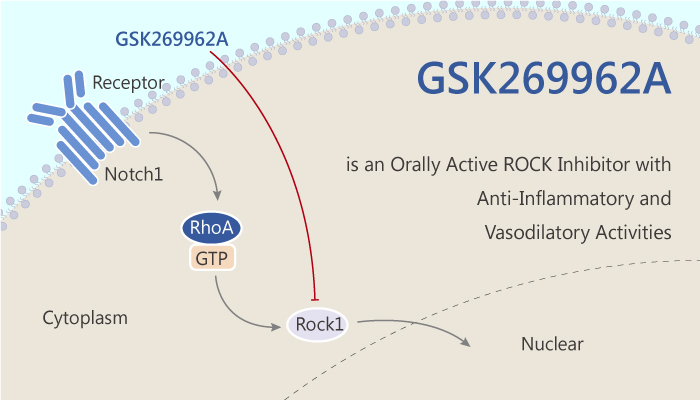Rho kinase (ROCK) belongs to a family of Ser/Thr protein kinases. ROCK is an effector of the small GTPase Rho and belongs to the AGC family of kinases. ROCK has pleiotropic functions including the regulation of cellular contraction, motility, morphology, polarity, cell division, and gene expression. In particular, ROCK1 and 2 are Rho-GTPase effectors that control key aspects of the actin cytoskeleton. ROCK participates in a variety of important physiological functions in the vasculature, including smooth muscle contraction, cell proliferation, cell adhesion, migration, and many aspects of inflammatory responses. GSK269962A represents a class of ROCK inhibitor with high potency and good protein kinase selectivity.

GSK269962A potently inhibits ROCK enzymatic activity. Especially, GSK269962A has an IC50 value of 1.6 nM toward recombinant human ROCK1. GSK269962A also exhibits more than 30-fold selectivity against a panel of serine/threonine kinases. Moreover, GSK269962A potently inhibits human ROCK2 with an IC50 of 4 nM. In macrophages, GSK269962A suppresses IL-6 mRNA transcription and reduces LPS induced IL-6 and TNF-α protein production. Furthermore, GSK269962A induces vasorelaxation in preconstricted rat aorta with an IC50 of 35 nM. In addition, GSK269962A completely abolishes the actin stress fiber formation induced by angiotensin II in human smooth muscles.
Oral administration of GSK269962A produces a profound dose-dependent reduction of systemic blood pressure in spontaneously hypertensive rats. At doses of 1, 3, and 30 mg/kg, GSK269962A induces a reduction in blood pressure of approximately 10, 20, and 50 mm Hg. GSK269962A potently reduces blood pressure in both spontaneously hypertensive rat and, deoxycorticosterone acetate-treated hypertensive rats, while having a much smaller effect on blood pressure in normotensive animals.
In summary, GSK269962A represents a class of ROCK inhibitors with anti-inflammatory and vasodilatory activities.